Previous Chapter « Table of Contents » Next Chapter
Following good management processes is the key to any successful road program. When practitioners focus on broad, fundamental programmatic elements, the details are easier to conceive and manage. By spending the time and the money up front to design and refine site- specific best practices, beneficial results will follow over the life of roadways.
Conversations about how and what chemical treatments can be used to enhance unpaved road management programs often center on a search for a single "one-size-fits-all" product. Such an easy solution is yet, and is unlikely, to be developed. Numerous factors must be considered when managing unpaved roads, including the engineering of the road, who uses the road and why, politics, economics, environmental impacts, training, staffing, cost, and the satisfaction of the customers being served.
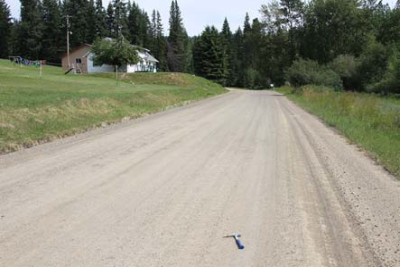
Figure 1. Photo. Good unpaved road.
The work of a successful road manager is not simply crunching numbers in financial statements any more than it is simply identifying a chemical treatment that works well. The successful road manager knows that a chemical additive will only work well when it's applied to a properly engineered roadway, the road is appropriately maintained, and the treatment is rejuvenated at optimal time intervals.
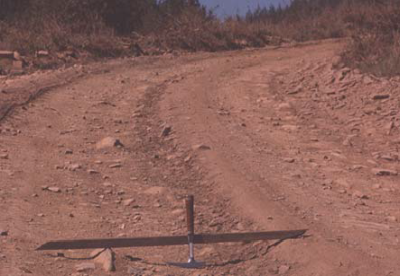
Figure 2. Photo. Poor unpaved road.
The most successful management programs are those that consider not just the price tag of chemical applications on a single stretch of road, but that factor in all costs and benefits involved in maintaining the entire network of roads in a jurisdiction over time. This includes identifying the price, both economic and environmental, of doing nothing, which can lead to higher costs "down the road" to remediate a bad situation. The public expectation placed on the road manager is to preserve and maintain the road system by keeping the roads dust free, properly shaped, providing a safe driving surface, limiting material loss, and quickly responding to citizen concerns (Figure 1 vs. Figure 2). Chemical treatments, when carefully selected, applied, and maintained, can provide a cost-effective means of satisfying these expectations. While some practitioners differentiate between "dust control" (typically spray-on applications to the surface) and "road stabilization" (typically mixed-in applications) practices, the two are closely linked and the decision to use one or the other is best based on an assessment of the problem and resources at hand to address it.
"I think that the genius of the road manager's clear success was that he did what only one percent of managers do - manage the decision-making process by communicating the cost of not doing what he was recommending." - A Scan Team member
This handbook identifies key issues to consider when using chemical dust control and stabilization additives as part of an unpaved road management program. It covers economic justification, evaluating the road, selecting an appropriate additive, applying the additive, and considering the environmental implications.
This handbook has been developed from observations made during the 2010 National Scan of Best Practices for Chemical Treatments on Unpaved Roads sponsored by the Federal Highway Administration's Central Federal Lands Highway Division and coordinated by the Western Transportation Institute at Montana State University and Meetings Northwest, LLC. The driving force behind this Scan was a recognition that road dust and the chemicals used to control it pose engineering, economic, regulatory, health, safety, and environmental challenges, and that these need to be quantified and approaches developed to address them.
This is the work of more than 20 individuals, listed in Appendix A, with unique expertise and backgrounds from government, academia and industry who joined together on three efforts, namely assessing the national state of the practice with regard to chemical treatments on unpaved roads (Kociolek, 2013) and identifying host sites for the Scan; visiting selected sites that offered examples of best practices in Arkansas, Colorado, Idaho, and Montana; and authoring this handbook.
The Scan began with the objective of identifying a clear set of best practices to share with the nation's road practitioners. It soon became evident that "best" means what's appropriate to a particular situation, and the Scan team agreed that a clear plan and management strategy for any unpaved road network is more important than simply focusing on the "best" chemical additive. While numerous questions were asked of the road managers who hosted the Scan at each of the sites, the Team's ultimate focus was to find the answers to three key questions:
The team followed a consistent process for each set of roads visited on the Scan:
As such, there was no time for "research" during the Scan. Each evaluation was a snapshot in time - a chance to get an overall perspective of the road condition at one stage of its treated life. The process provided the opportunity for an independent review of practices, including what appeared to be working and what could use improvement. With 10 perspectives, the team's goal was not to achieve consensus, but rather to capture the range of observations for what makes an effective practice and program.
The travel team visited nine sites to observe the operations and results of unpaved road practitioners' programs as listed in Table 1.
Most of the host site roadways were considered low volume, carrying between 50 and 400 vehicles per day. Two of the roadways were more traveled - one had a seasonal count of about 1,200 vehicles per day (Figure 6) and the other had about 800 per day, 15 percent of which were large trucks. Similar to the state of the practice nationally (Kociolek, 2013), all hosts used magnesium chloride (MgCl2) or a magnesium chloride blend on some or all of their roads, with the exception of one who used an enzyme.

Figure 3. Photo. Listening to the practitioner.
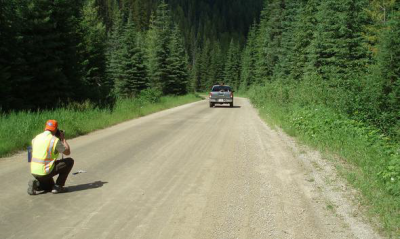
Figure 4. Photo. Driving a road section.
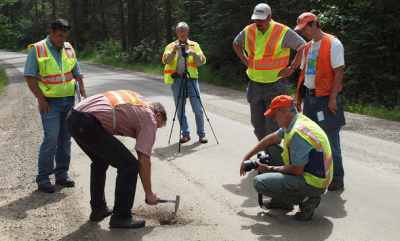
Figure 5. Photo. Evaluating the road.
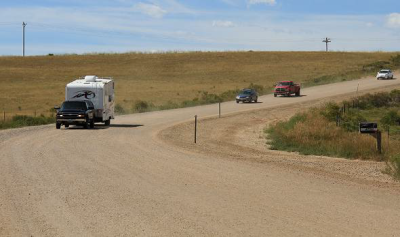
Figure 6. Photo. Unpaved road traffic.
| General Location | Agency | Chemical Treatment |
|---|---|---|
| Northern Idaho | Lakes Highway District | Chloride |
| Northern Idaho | Bonner County | Chloride |
| Idaho/Montana Border | Lolo National Forest | Chloride |
| Western Montana | Missoula County | Chloride |
| Northwestern Arkansas | Ozark-St. Francis National Forest | Enzyme |
| Northern Colorado | Larimer County | Chloride/lignin blend |
| Northern Colorado | Weld County | Lignin and chloride/lignin blend |
| Northern Colorado | Boulder County | Chloride/lignin blend |
| Northern Colorado | Douglas County | Chloride/lignin blend |
Rather than simply producing a recap of scan tour observations, the travel team decided to write a document that melds together scan tour observations with other best practices and basic technical information. What makes this handbook unique is that it represents a culmination of intensive contemplation and debate by a team of experts who willingly engaged on this effort to identify the complex challenges of managing an unpaved road network. It should not be considered a stand-alone guideline for designing, constructing, maintaining and managing an unpaved road, but rather a handbook that supplements existing excellent references on the topic.
To best manage unpaved roads, an intentional and sustainable program is recommended that includes the following components:
A fundamental misconception that needs to be corrected is that this handbook is about identifying the best product to use; it is not. Nor is it a comprehensive evaluation of the performance of all available dust palliatives and soil stabilizers. Neither is it an endorsement of the products used at the sites that were visited on this Scan, nor is it intended to convey that these products are the only ones recommended for use. Rather, this handbook is about identifying and intentionally following a process to best manage an unpaved road system using chemical treatments, either sprayed directly onto the road to control dust, or mixed into the surface layer to improve the material properties, to improve all-weather passability, as well as to reduce dust levels.